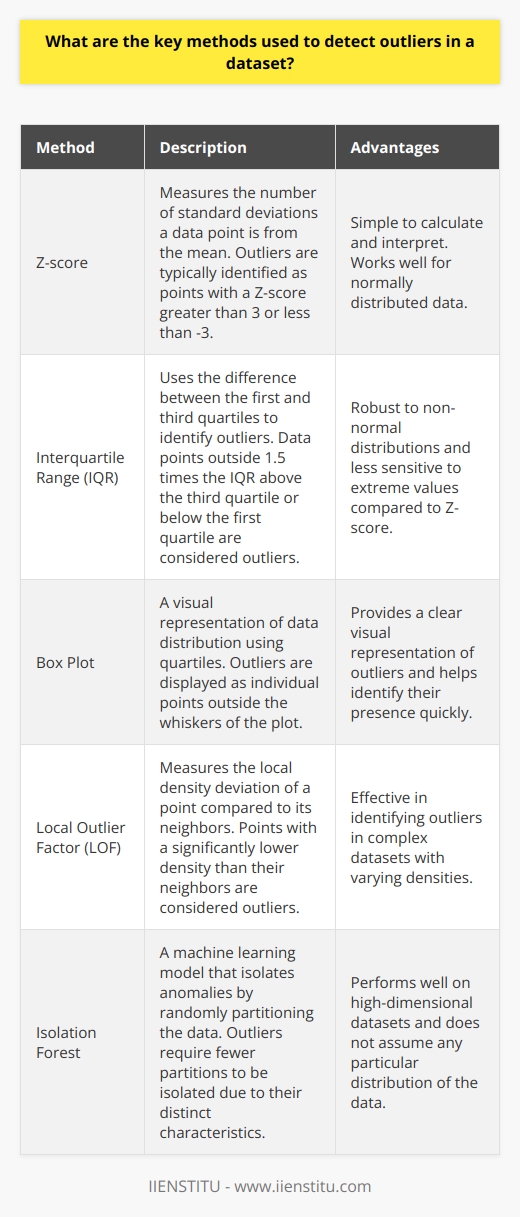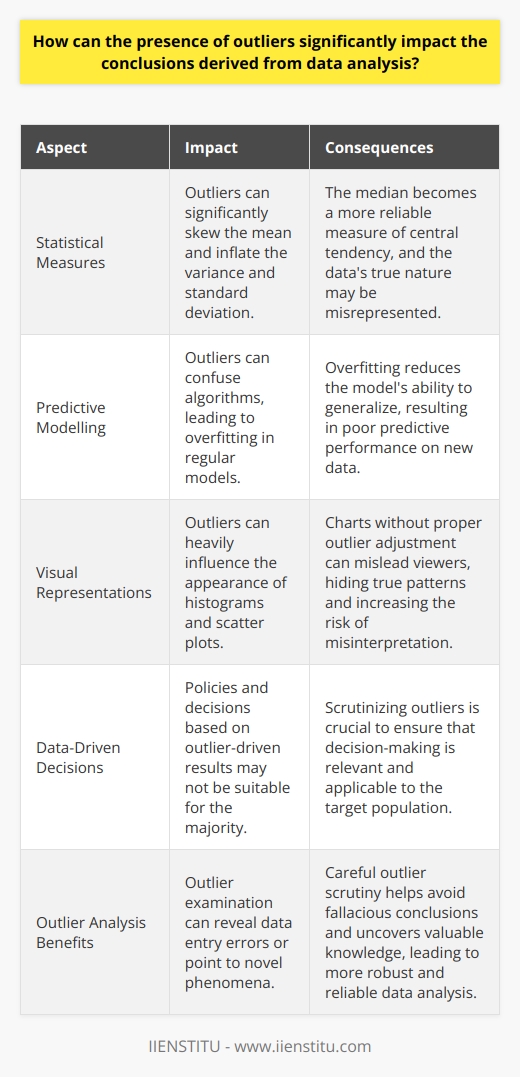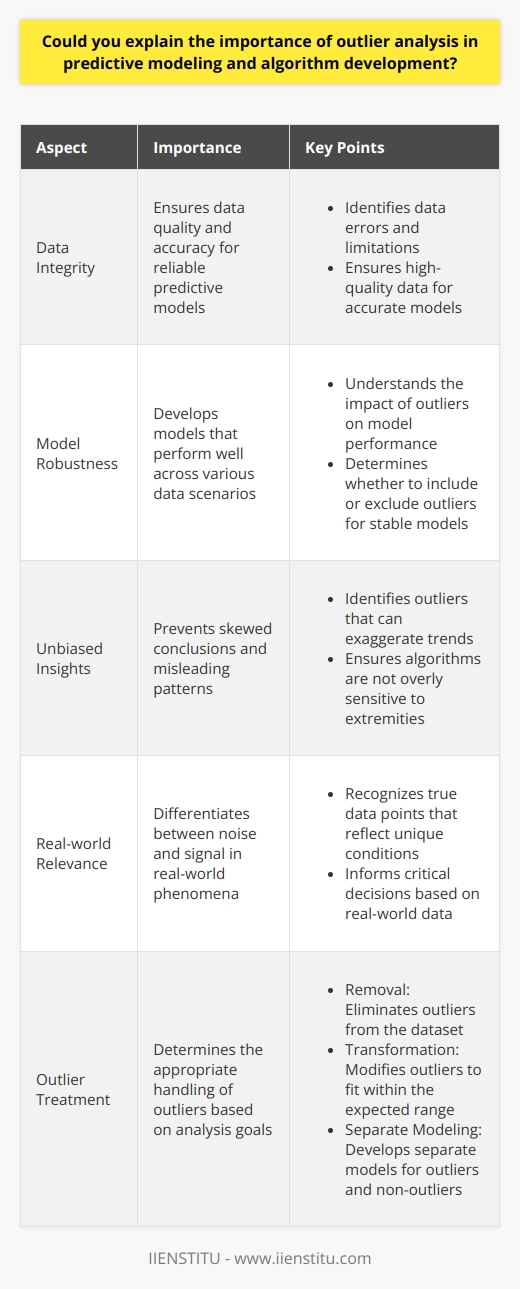
Outlier Analysis is the process of identifying and reacting to anomalous data within a dataset. These outliers can significantly skew results, leading to distorted conclusions and misleading information. As such, outlier analysis is a critical step in data interpretation and forms the crux of robust data analysis in various fields such as finance, healthcare, and cybersecurity. In this expansive blog post, we will delve deep into understanding outliers, explore the methods used to detect them, discuss their impact, and scrutinize how they can be effectively managed.
Furthermore, we will illustrate the real-world application of outlier analysis across industries, thereby emphasizing its fundamental role in data-driven decision-making.
Understanding Outliers
Explanation of what outliers are
An outlier is an observation that diverges dramatically from the norm within a dataset. From a statistical perspective, these are data points that fall outside of the overall pattern of distribution. Outliers can either be extremely high or extraordinarily low comparative to the rest of the data. Hence, identifying these unusual observations is essential for accurate analysis.
From a real-world perspective, outliers may represent innovation, error, or an underlying shift in a process. Understanding their nature is the first step in leveraging their presence for informed decision-making.
Causes of outliers
The emergence of outliers can typically be attributed to several causes. Data entry errors, such as mistyping or misreading values, introduce inaccuracies that can create outliers. Measurement errors occur due to faulty equipment or observer error, distorting the data. Experimental errors may arise from issues with the research design or execution.
And at times, intentional outliers are created through deliberate manipulation or fraudulent activity. Recognizing the sources of outliers is essential for determining the correct approach to managing them.
Types of outliers
Outliers come in various forms and understanding these can greatly aid in their identification. Univariate outliers stand out in one dimension, for example, an unusually high salary in a dataset of incomes. Multivariate outliers are atypical in several dimensions simultaneously – perhaps a data point with an unlikely combination of high income and low education in a socioeconomic dataset.
Global outliers are anomalous compared to the entire dataset, whereas contextual outliers are unusual only within a specific context or subset. Lastly, collective outliers could indicate a significant shift in data trends and would be critical to identify, as they may signal fundamental changes in behaviors or systems.
Methods of Detecting Outliers
Using Graphical Methods
Visualizations are potent tools for identifying outliers. A Box Plot, for instance, illustrates the distribution of data and clearly outlines data points that fall far outside the interquartile range. Scatter Plots can reveal outliers as points that deviate markedly from the data cloud. Furthermore, Z-Score plots can be used to visualize how many standard deviations a data point is from the mean; data points with a high Z-score are potential outliers.
Using Statistical Tests
A more empirical approach to detecting outliers is through statistical tests. The Z-Score Method is commonly used and identifies outliers by considering the number of standard deviations a datum is from the mean. Grubbs' Test is another test, suitable for detecting a single outlier by comparing the extreme values to the rest. Turkey's Test is akin to Grubbs’ but is better equipped for large data sets. However, these tests should be applied judiciously since they rely on assumptions about the data distribution that might not always hold true.
Using Machine Learning Techniques
Advanced methods for outlier detection incorporate machine learning algorithms. K-Means Clustering can detect outliers as points that do not belong to any cluster. DBSCAN, a density-based clustering method, identifies outliers as points in low-density regions. The Isolation Forest algorithm, on the other hand, isolates anomalies instead of profiling normal data points. When applying these machine learning techniques, practitioners should pay close attention to the hyperparameters and assumptions innate to each method as they significantly affect detection sensitivity and specificity.
Impact and Handling of Outliers
Explain the impact of outliers
Outliers can dramatically mislead data interpretation by distorting statistical measures like the mean and variance, leading to flawed analyses and decisions. Their impact on modelling and predictions is also noteworthy, as they can dramatically affect the performance and accuracy of predictive models. Being conscious of this impact is critical when dealing with outliers, as their presence can signify either noise that needs filtration or valuable data that may warrant further investigation.
Techniques of handling outliers
Several techniques are employed to handle outliers. Deletion is a straightforward approach but runs the risk of losing valuable information. Transformation methods, such as logarithms or square roots, can normalize data distributions, making outliers less pronounced. Imputation replaces outlier values with more typical values derived from other data points. Alternatively, one can opt to treat outliers separately, which can be a potent way of understanding anomalies without compromising the integrity of the dataset.
Evaluating the effects of these techniques
The critical takeaway when handling outliers is that the technique used should match the context and purpose of the analysis. When deciding which method to use, one should rigorously weigh the risks and benefits of each approach. Some techniques may introduce bias or change the structure of data. Thus, each method's effect on the interpretability and reliability of the results must be thoroughly evaluated to ensure that the final analysis continues to support sound decision-making.
Outlier Analysis in Practice
Use cases of outlier analysis across industries
Outlier analysis finds applications across diverse fields. In the finance sector, identifying outliers can aid in detecting fraudulent transactions. In the healthcare industry, outliers in patient data may indicate rare diseases or errors in recording information. Cybersecurity relies on outlier analysis to identify unusual network traffic that could signify a security breach. Supply chain management uses outlier detection to spot discrepancies in inventory or logistics data, which could indicate inefficiencies or errors in the workflow.
Example explanations showcasing the real-world impact of outliers and their handling
Consider the case of fraudulent credit card usage, an outlier in transaction patterns can alert analysts to possible criminal activity, potentially saving both financial institutions and customers from losses. In healthcare, outliers in patient recovery rates may uncover new treatment methods or care management practices that could enhance patient outcomes. The ability to handle these scenarios effectively, through robust outlier analysis, is essential for translating these insights into actionable intelligence.
Conclusion
In summary, outlier analysis serves a pivotal role in refining data accuracy and, by extension, the quality of the insights derived from it. We have outlined the various types of outliers, methods to detect them, and strategies for managing their impact. By appreciating the implications of outlier analysis and applying it judiciously across domains, organizations can sharpen their problem-solving skills training and support data-informed decisions. Further education on the subject, such as an online certificate course in data analysis, can empower professionals with the skills to navigate and capitalize on the intricacies of outlier analysis. In the age of big data, mastering outlier analysis is not merely an academic pursuit but a necessary skill for anyone looking to harness the full power of data in their respective fields.
Frequently Asked Questions
What are the key methods used to detect outliers in a dataset?
Understanding Outliers
Outliers are uncommon values. They differ significantly from other observations. These data points can indicate variability in measurement, experimental errors, or a novel discovery. In data analysis, outlier detection is crucial. It ensures statistical analyses are not unduly influenced.
Common Outlier Detection Methods
Statistical Tests
Z-score represents the number of standard deviations from the mean. A common threshold is 3 or -3. Beyond it, the data point is an outlier. The IQR score uses the interquartile range. Data outside the range, typically 1.5 times the IQR above the third quartile or below the first quartile, are outliers. The Grubbs' test detects one outlier at a time, based on a significant difference from the sample mean.
Visualization Techniques
Box plots provide a visual representation. Outliers appear as points outside the whiskers. Scatter plots show data distribution. Outliers can be visually identified as points lying away from the cluster.
Proximity-Based Methods
DBSCAN clusters data points together. Points not belonging to a cluster are outliers. Local Outlier Factor (LOF) assesses the local density deviation of a point with respect to its neighbors. An anomalously low density indicates an outlier.
Predictive Modeling
Machine learning models such as Isolation Forest and One-Class SVM are useful. These models isolate anomalies instead of profiling normal data patterns. An isolation forest, for instance, employs random partitioning. It isolates outliers because they are few and different. A one-class SVM learns the properties of normal cases. It can then detect anomalies in new observations.
Ensemble Methods
Feature Bagging combines several outlier detection models. It improves the stability and accuracy. The ensemble approach can reduce the possibility of model-specific errors affecting the outcome.
Importance of Context
Each method has strengths and limitations. The context and nature of the data dictate the best approach. Understanding the domain is key to choosing an effective outlier detection method. Users must carefully interpret outlier results. They must not hastily discard data points.
Conclusion
Various methods exist to detect outliers in a dataset. Each method offers unique advantages. Analysts must understand these methods. They also need a clear grasp of their dataset characteristics. This combination ensures robust outlier detection and reliable data analysis.

How can the presence of outliers significantly impact the conclusions derived from data analysis?
Understanding Outliers in Data Analysis
Defining Outliers
Outliers stand as data points distinct from the rest. They lie outside the overall pattern. An outlier’s presence can skew results. Researchers scrutinize these values intently.
Impact on Statistical Measures
Outliers affect mean values profoundly. They pull the average towards them. As a result, the median becomes a better central tendency measure. Likewise, outliers inflate the variance. They lead to an increased standard deviation. Such distortions misrepresent the data’s true nature.
Effect on Predictive Modelling
In predictive modelling, outliers confuse algorithms. Robust machine learning models resist this. However, regular models may overfit. Overfitting curbs the model's ability to generalize. Thus, predictive performance on new data suffers.
Misleading Representations
Visual representations gain from outlier assessment. Histograms and scatter plots expose outlier influence. Charts without outlier adjustment mislead viewers. True patterns remain hidden. Misinterpretation becomes a risk.
Data-Driven Decisions and Outliers
Policies and decisions stem from data analysis. Outlier-driven results could forge unsuitable policies. These decisions may not apply to the majority. Therefore, scrutinizing outliers ensures relevant decision-making.
Outlier Analysis Benefits
Outlier examination grants insights. It might signal data entry errors. Alternatively, it could point to novel phenomena. Thus, outlier scrutiny serves dual purposes. It avoids fallacious conclusions. It also uncovers knowledge.
Concluding Thoughts
Outliers hold immense analytical sway. They reshape statistical metrics. They mislead visual data presentation. They affect model accuracy. However, when identified, they offer valuable, unique insights. Careful handling of outliers ensures robust, reliable data analysis. Intelligent outlier management provides a clearer understanding of data. Consequently, data-driven decision-making improves.

Could you explain the importance of outlier analysis in predictive modeling and algorithm development?
Definition of Outlier Analysis
Outlier analysis identifies unusual data points. These points differ significantly from most of the data. We can say they are statistical anomalies. In predictive modeling, they are crucial. They can strongly influence the model's performance.
The Importance in Predictive Modeling
Understand Data Integrity
Outlying data can indicate errors. It may also reflect limitations in data collection. Thus, outlier analysis ensures data quality. Data with high integrity is crucial for accurate models.
Ensure Robust Models
Models must make accurate predictions. They should do this across various data scenarios. Therefore, we need to understand outliers. Including or excluding them affects model robustness. We aim for models stable in the presence of new, unseen data.
Avoid Skewed Insights
Outliers can skew model results. They can exaggerate trends or patterns. This is especially true for algorithms sensitive to extremities. Therefore, outlier analysis can prevent misleading conclusions.
Provide Real-world Relevance
Some outliers are true data points. They reflect real-world phenomena. Thus, they merit attention and analysis. We need to differentiate noise from signal. This is critical for models that inform critical decisions.
Steps in Outlier Analysis for Algorithm Development
Detect Outliers
First, we must identify outliers. Various statistical methods exist. They include standard deviation, IQR, and Z-scores. Visualizations like box plots also help.
Assess Outliers
Next, we assess their impact. Researchers must decide why these points are outliers. Possible reasons include data entry errors or unique conditions.
Decide on Treatment
Last, we decide how to handle outliers. Options include:
- Removal
- Transformation
- Separate modeling
The choice depends on the analysis goal.
Conclusion
Outlier analysis is crucial for effective modeling. It ensures data quality and model accuracy. Moreover, it guards against skewed insights. Furthermore, it reaffirms the real-world relevance of the model. Every phase of algorithm development benefits. Hence, outlier analysis is indispensable.



